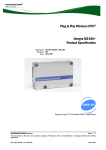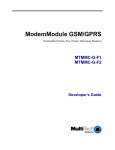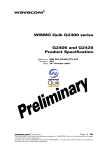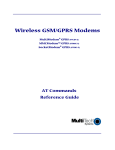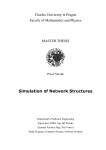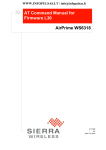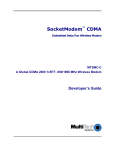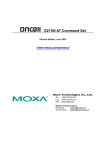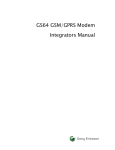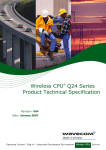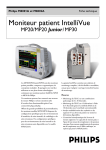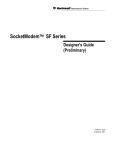Download Multitech MTSMC-G-F1 Specifications
Transcript
SocketModem™ GSM/GPRS Embedded Data/Fax Wireless Modem MTSMC-G-F1 – Global GSM/GPRS Class 10, 900/1800 MHz MTSMC-G-F2 – Global GSM/GPRS Class 10, 850/1900 MHz Developer’s Guide Table of Contents Table of Contents CHAPTER 1 – PRODUCT DESCRIPTION AND SPECIFICATIONS .......................................................... 4 PRODUCT DESCRIPTION ............................................................................................................................... 4 APPLICATIONS.............................................................................................................................................. 4 PRODUCT FEATURES.................................................................................................................................... 5 FEATURE DETAILS ........................................................................................................................................ 5 DEVELOPER’S KIT ........................................................................................................................................ 5 TECHNICAL SPECIFICATIONS ......................................................................................................................... 6 RELATED MANUALS ...................................................................................................................................... 6 ADDITIONAL INFORMATION ............................................................................................................................ 6 CHAPTER 2 – MECHANICAL SPECIFICATIONS ...................................................................................... 7 PHYSICAL DIMENSIONS................................................................................................................................. 7 PIN CONFIGURATIONS .................................................................................................................................. 8 Pin Descriptions...................................................................................................................................... 8 CHAPTER 3 – ELECTRICAL CHARACTERISTICS ................................................................................... 9 I/O ELECTRICAL CHARACTERISTICS .............................................................................................................. 9 POWER CONSUMPTION ................................................................................................................................. 9 SIM INTERFACE ELECTRICAL CHARACTERISTICS ......................................................................................... 10 HANDLING PRECAUTIONS ........................................................................................................................... 10 CHAPTER 4 – SOCKETMODEM INTERFACES....................................................................................... 11 FLASHING LED .......................................................................................................................................... 11 SIM INTERFACE ......................................................................................................................................... 11 RF INTERFACE ........................................................................................................................................... 12 RF Connector ....................................................................................................................................... 12 RF Performances.................................................................................................................................. 12 CHAPTER 5 – SOCKETMODEM TEST BOARD ...................................................................................... 13 SERIAL TEST/DEMO BOARD COMPONENTS .................................................................................................. 13 SERIAL TEST/DEMO BOARD BLOCK DIAGRAM .............................................................................................. 13 CHAPTER 6 – APPLICATION CONSIDERATIONS.................................................................................. 16 GENERAL GUIDELINES FOR THE USE OF THE SOCKETMODEM....................................................................... 16 Hardware and RF ................................................................................................................................. 16 The Antenna ......................................................................................................................................... 16 FIRMWARE UPGRADE ................................................................................................................................. 16 INITIAL CONFIGURATION USING MOBILE PHONETOOLS ................................................................................. 16 APPENDIX A – SAFETY PRECAUTIONS & REGULATORY STANDARDS COMPLIANCE.................. 17 SAFETY PRECAUTIONS ............................................................................................................................... 17 RF Safety.............................................................................................................................................. 17 General Safety...................................................................................................................................... 18 Safety Standards .................................................................................................................................. 19 RF Exposures ....................................................................................................................................... 19 Instructions to OEMs ............................................................................................................................ 19 REGULATORY STANDARDS COMPLIANCE ..................................................................................................... 20 GSM compliance .................................................................................................................................. 20 APPENDIX B – SOURCES FOR PERIPHERAL DEVICES ...................................................................... 21 GSM ANTENNA.......................................................................................................................................... 21 APPENDIX C – AT COMMAND LIST ........................................................................................................ 22 APPENDIX D – ACRONYMS AND ABBREVIATIONS ............................................................................. 26 INDEX ......................................................................................................................................................... 27 3 Chapter 1 – Product Description and Specifications Chapter 1 – Product Description and Specifications Product Description The Multi-Tech SocketModem GSM/GPRS is a complete, ready-to-integrate, embedded wireless modem. Designed for global use, it offers standards-based multi-band GSM/GPRS Class 10. The SocketModem GSM/GPRS is based on industry-standard open interfaces and utilizes the same form factor as the SocketModem, SocketModem IP, or SocketEthernet IP modules from Multi-Tech. Multi-Tech’s Wireless SocketModem GSM/GPRS Product Description Region MTSMC-G-F1 MTSMC-G-F2 GMS/GPRS Class 10, 900/1800 MHz GMS/GPRS Class 10, 850/1900 MHz Global Global Applications The GSM/GPRS SocketModems are used to integrate wireless data and fax communications into numerous embedded applications. They are targeted at applications that periodically need to send or receive data over a wireless network and are ideal solutions for: · · · · · · · · · · · Appliances ATM terminals Automotive Data collection Gas pumps Industrial and medical remote monitoring systems Remote diagnostics Remote metering Security systems Vending/gaming machines Other devices requiring wireless connectivity 4 Chapter 1 – Product Description and Specifications Product Features · · · · · · · · · · GPRS Class 10 Dual-band 850/1900 or 900/1800 GSM/GPRS GSM Class 1 and Class 2 Group 3 FAX Short Message Services features including text and PDU, point to point, cell broadcast 14.4K GSM circuit switched data MMCX antenna connector and SIM socket Serial interface supports DTE speeds to 115.2K AT command compatible* V.42bis data compression ME + SIM phone book management *AT Commands - AT commands for this product are published in a separate document available on the system CD and from Multi-Tech. For a copy of this documents contact OEM Sales at: [email protected] or call (800) 972-2439. Feature Details Integration Reduces Space, Power, and Cost – The SocketModem GSM/GPRS integrates the controller, RF transceiver, and antenna interface in one module. This integration requires low power, low real estate and provides an overall reduction in costs. Reduces Development Time – The SocketModem GSM/GPRS can make your existing and next generation device, machine, or system, communication-ready without requiring significant hardware changes to its design. This complete, ready-to-integrate wireless SocketModem allows you to enhance your product while you focus on developing its core features. Short Message Services – The SocketModem GSM/GPRS offers SMS features such as text and PDU, point-to-point (MT/MO) and cell broadcast. Management Features – The SocketModem GSM/GPRS provides advanced management features that include: phone book management, fixed dialing number, real time clock and alarm management. Industry-standard Modem Commands – The SocketModem GSM/GPRS provides industrystandard AT-style commands for ease of integration into your existing software application. SocketModem Pin-Out – The SocketModem GSM/GPRS interfaces easily with existing products through a standard serial communication channel. The complete on-board RF transceiver interfaces with an antenna for direct connection to wireless SMS, circuit-switched dial-up, or packet data networks. The SocketModem also includes an onboard LED to display network status. The SocketModem is a Data Terminal Equipment (DTE) device with serial asynchronous protocol support. The serial DTE channel is capable of transfer speeds to 115.2K bps and can be interfaced directly to a UART or microcontroller. Developer’s Kit The SocketModem GSM/GPRS Developer’s Kit allows you to plug in the SocketModem and use it for testing, programming, and evaluation. The kit includes: · one development board · RS-232 DB-25 connector · universal power supply · antenna · RS-232 cable 5 Chapter 1 – Product Description and Specifications Technical Specifications The SocketModem GSM/GPRS meets the following specifications: Fax Compatibility Weight Dimensions Power Requirements Operating Environment Storage Temperature Certifications Cleaning GSM Class 1 and Class 2 Group 3 Fax 26 g (1 oz.) 3.1” w x 1.4” h x 0.5” d (8.0 cm x 3.5 cm x 1.2 cm) 5 VDC; 400mA Average, 2A Peak -20° to +55° C -30° to +85° C CE Mark EMC: FCC Part 2, 15, 22, 24, EN 55022 & EN55024 Safety: UL 60950, EN 60950 No cleaning/washing due to the manufacturing process used to produce this product Additional Information European Telecommunications Standards Institute (ETSI) - Contact the ETSI at: 650, route des Lucioles 06921 Sophia-Antipolis Cedex France Tel: +33 (0)4 92 94 42 00 Fax: +33 (0)4 93 65 47 16 http://www.etsi.org Global Engineering Documents manages a collection of more than one million documents from over 460 organizations worldwide: http://global.ihs.com Phone: 800-854-7179 Fax: 303-792-2192 The ITU is the leading publisher of telecommunication technology, regulatory and standard information, with over 4,000 titles in printed form, on CD-ROM and online at: http://www.itu.int/publications/ . 6 Chapter 2 – Mechanical Specifications Chapter 2 – Mechanical Specifications Physical Dimensions SocketModem GSM/GPRS Mechanical Drawing 7 Chapter 2 – Mechanical Specifications Pin Configurations The SocketModem GSM/GPRS uses a 13-pin interface. SocketModem Pins - Top View Pin Descriptions Pin # 24 26, 41, 63 33 34 35 36 37 38 39 40 61 Signal I/O Description Name Type -RESET I Reset. This signal is used to force a reset procedure by providing low level during at least 500µs. This signal has to be considered as an emergency reset only. A reset procedure is already driven by an internal hardware during the power-up sequence. This signal can also be used to provide a reset to an external device. It then behaves as an output. If no external reset is necessary, this input can be left open. If used (emergency reset), it has t o be driven by an open collector or an open drain. GND Ground –RTS I Request to Send. RTS signal is used for hardware flow control. –RXD O Received Data. The modem uses the RXD line to send received data to the DTE and to send modem responses to the DTE. –TXD I Transmitted Data. The DTE uses the –TXD line to send data to the modem or to transmit commands to the modem. –RI O Ring Indicate. –RI output ON (low) indicates the presence of an ON segment of a ring signal. –DSR O Data Set Ready. -DSR indicates modem status to the DTE. –DSR OFF (high) indicates that the DTE is to disregard all signals appearing on the interchange circuits except Ring Indicator (–RI). It reflects the status of the local data set, and does not indicate an actual link with any remote data equipment. –CTS O Clear To Send. –CTS is controlled by the modem to indicate whether or not the modem is ready to transmit data. –CTS ON, indicates to the DTE that signals presented on TXD will be transmitted. –CTS OFF indicates to the DTE that it should not transfer data across the interface on TXD. –DCD O Data Carrier Detect. –DCD output is ON (low) when a data connection is established. –DTR I Data Terminal Ready (Active Low). The –DTR input is turned ON (low) by the DTE when the DTE is ready to transmit or receive data. –DTR ON prepares the modem to be connected, and, once connected, maintains the connection. –DTR OFF places the modem in the disconnect state. VCC PWR +5V 8 Chapter 3 – Electrical Characteristics Chapter 3 – Electrical Characteristics Electrical characteristics for the 5V Serial SocketModem are presented in this chapter. I/O Electrical Characteristics 5 Vdc Characteristics (TA = -20° C to 55° C; VDD = 5 V ± 0.25 V) Digital Inputs –DTR (40), –TXD (35), –RTS (33), –RESET (24) Digital Outputs –DCD (39), –CTS (38), –DSR (37), –RI (36), –RXD (34) Digital Input Capacitance VDDMAX = 5.25 V Input High Min 3.675 V Output High Min. 4 V Input Low Max 1.4 V Output Low Current Max 0.4 V Drive: 2 ma 5 PF Power Consumption Power Consumption in OFF Mode Overall Consumption Conditions Off INOM 5 mA IMAX 10 mA Power Consumption in EGSM/GPRS 900 MHz and GSM/GPRS 850 MHz Mode +5V +5V +5V +5V +5V +5V +5V +5V Conditions During TX bursts @PcI5 During RX bursts Average 1 Rx/1Tx @PcI5 Average 1 Rx/1Tx @PcI8 Average Idle Mode Average 1 GPRS CI 10 (3Rx/2Tx) @PcI5 Average 1 GPRS CI 10 (3Rx/2Tx) @PcI8 Average 1 Idle Mode INOM 1.7 A peak 75 mA peak 270 mA 180 mA 100 mA 540 mA 360 mA 2.2 mA IMAX 2.0 A peak 80 mA peak 370 mA 200 mA 300 mA 640 mA 400 mA 3 mA Power Control Level: PcI5=2W typ.; PcI8=0,5W typ. Power Consumption in GSM/GPRS 1800 & 1900 MHz Modes +5V +5V +5V +5V +5V +5V +5V +5V Conditions During TX bursts @PcI0 During RX bursts Average 1 Rx/1Tx @PcI0 Average 1 Rx/1Tx @PcI3 Average Idle Mode Average 1 GPRS CI 10 (3Rx/2Tx) @PcI0 Average 1 GPRS CI 10 (3Rx/2Tx) @PcI3 Average 1 Idle Mode INOM 1.3 A peak 75 mA peak 240 mA 150 mA 100 mA 480 mA 300 mA 2.2 mA IMAX 1.7 A peak 80 mA peak 270 mA 180 mA 300 mA 540 mA 360 mA 3 mA Power Control Level: PcI0=1W typ.; PcI3=0,25W typ. 9 Chapter 3 – Electrical Characteristics SIM Interface Electrical Characteristics SIM Interface Electrical Characteristics This information is repeated in the next chapter under the SIM Interface section. Parameter SIMDATA VIH SIMDATA VIL SIMRST, SIMDATA SIMCLK VOH SIMRST, SIMDATA SIMCLK VOL SIMVCC Output Voltage SIMCLK Rise/Fall Time SIMRST, SIMDATA Rise/Fall Time SIMCLK Frequency Conditions IIH = +/- 20mA IIL = 1 mA Source current = 20mA Min 0.7xSIMVCC Typ SIMVCC – 0.1V Sink current = -200mA ISIMVCC <= 6mA Loaded with 30pF Loaded with 30pF Loaded with 30pF Max Unit V 0.3xSIMVCC V V 0.1 2.70 2.80 2.85 50 1 V ns ms 3.25 MHz Handling Precautions All devices must be handled with certain precautions to avoid damage due to the accumulation of static charge. Although input protection circuitry has been incorporated into the devices to minimize the effect of this static buildup, proper precautions should be taken to avoid exposure to electrostatic discharge during handling and mounting. 10 Chapter 4 - SocketModem Interfaces Chapter 4 – SocketModem Interfaces This chapter describes the SocketModem interfaces. · Flashing LED · SIM Interface · RF Interface Flashing LED The flashing LED signal is used to indicate the working mode of the SocketModem. LED and SocketModem Status Signal OFF ON SocketModem Status Download mode or switched OFF> Continuously lit Switched ON (not registered on the network) Flashing Switched ON (registered on the network) SIM Interface The internal SIM interface of the SocketModule supports 3V SIMs only. Note: This interface is fully compliant with GSM 11.11 recommendations concerning the SIM functionality. Five Signals Are Available SIMVCC: SIM power supply. SIMRST: reset. SIMCLK: clock. SIMDATA: I/O port. SIMPRES1 SIM card detect. 11 Chapter 4 - SocketModem Interfaces RF Interface The impedance is 50 Ohms nominal. RF Connector The RF connector is MMCX standard type. An antenna can be directly connected through the mating connector or using a small adapter. RF Performances RF performances are compliant with the ETSI recommendation 05.05 and 11.10. The main parameters are: Receiver: · EGSM Sensitivity : < -104 dBm · GSM 1800/GSM 1900 Sensitivity : < -102 dBm · Selectivity @ 200 kHz : > +9 dBc · Selectivity @ 400 kHz : > +41 dBc · Dynamic range : 62 dB · Intermodulation : > -43 dBm · Co-channel rejection : + 9 dBc Transmitter: · Maximum output power (EGSM) : 33 dBm +/- 2 dB · Maximum output power (DCS/PCS) : 30 dBm +/- 2 dB · Minimum output power (EGSM): 5 dBm +/- 5 dB · Minimum output power (DCS/PCS): 0 dBm +/- 5 dB · H2 level : < -30 dBm · H3 level : < -30 dBm · Noise in 925 - 935 MHz : < -67 dBm · Noise in 935 - 960 MHz : < -79 dBm · Noise in 1805 - 1880 MHz : < -71 dBm · Phase error at peak power : < 5 ° RMS · Frequency error : +/- 0.1 ppm max 12 Chapter 5 – SocketModem Test Board Chapter 5 – SocketModem Test Board Serial Test/Demo Board Components 13 Chapter 5 – SocketModem Test Board 14 Chapter 5 – SocketModem Test Board Serial Test/Demo Board Block Diagram Block Diagram for the SocketModem GSM/GPRS 15 Chapter 6 – Application Considerations Chapter 6 – Application Considerations General Guidelines for the Use of the SocketModem Hardware and RF · · · Ground plane: Multi-Tech recommends having a common ground plane for analog, digital and RF grounds. ESD protection on serial link, … Possible spurious emission radiated by the application to the RF receiver in the receiver band The Antenna The antenna sub-system and integration in the application is a major issue. It is a major issue in the choice of the antenna cable (type, length, performances, thermal resistance, etc.) These elements could affect GSM performances such as sensitivity and emitted power. The antenna should be isolated as much as possible from the digital circuitry including the interface signals. Multi-Tech recommends shielding the terminal. On terminals including the antenna, a poor shielding could dramatically affect the sensitivity of the terminal. Subsequently, the power emitted through the antenna could affect the application. Firmware Upgrade The SocketModem firmware is stored in flash memory and it can easily be upgraded. The upgrade procedure is based on the Xmodem protocol (AT+WDWL command). Nominal Upgrade Procedure The firmware file can be downloaded into the modem using the Xmodem protocol. To enter this mode, the AT+WDWL command (see description in the AT command manual) has to be sent to the SocketModem. The necessary serial signals to proceed with the Xmodem downloading are: Rx, Tx, RTS, CTS, GND. Initial Configuration Using Mobile PhoneTools For initial configuration of your wireless device, Multi-Tech offers a Windows-based mobile PhoneTools application. To load Mobile PhoneTools, click the Mobile PhoneTools icon on the system CD and follow the onscreen prompts. 16 Appendix A – Safety Precautions and Regulatory Standards Compliance Appendix A – Safety Precautions & Regulatory Standards Compliance Safety Precautions IMPORTANT! FOR THE EFFICIENT AND SAFE OPERATION OF YOUR GSM INTEGRATED MODEM READ THIS INFORMATION BEFORE USE. RF Safety General Your SocketModem is based on the GSM standard for cellular technology. The GSM standard is spread all over the world. It covers Europe, Asia, and some parts of America and Africa. This is the most used telecommunication standard. Your modem is actually a low power radio transmitter and receiver. It sends out and receives radio frequency energy. When you use your SocketModem integrated modem, the cellular system, which handles your calls controls both the radio frequency and the power level of your cellular modem. Exposure to RF Energy There has been some public concern about possible health effects of using GSM modems. Although research on health effects from RF energy has focused on the current RF technology for many years, scientists have begun research regarding newer radio technologies, such as GSM. After existing research had been reviewed, and after compliance to all applicable safety standards had been tested, it has been concluded that the product was fitted for use. If you are concerned about exposure to RF energy there are things you can do to minimize exposure. Obviously, limiting the duration of your calls will reduce your exposure to RF energy. In addition, you can reduce RF exposure by operating your cellular modem efficiently by following the below guidelines. Efficient Modem Operation For your modem to operate at the lowest power level, consistent with satisfactory call quality : · If your modem has an extendible antenna, extend it fully. Some models allow you to place a call with the antenna retracted. However your modem operates more efficiently with the antenna fully extended. · Do not hold the antenna when the modem is « IN USE ». Holding the antenna affects call quality and may cause the modem to operate at a higher power level than needed. Antenna Care and Replacement Do not use the modem with a damaged antenna. If a damaged antenna comes into contact with the skin, a minor burn may result. Replace a damaged antenna immediately. Consult your manual to see if you may change the antenna yourself. If so, use only a manufacturer-approved antenna. Otherwise, have your antenna repaired by a qualified technician. Use only the supplied or approved antenna. Unauthorized antennas, modifications, or attachments could damage the modem and may contravene local RF emission regulations or invalidate type approval. 17 Appendix A – Safety Precautions and Regulatory Standards Compliance General Safety Driving Check the laws and the regulations regarding the use of cellular devices in the area where you have to drive as you always have to comply with them. When using your modem while driving, please : give full attention to driving, pull off the road and park before making or answering a call if driving conditions so require. Electronic Devices Most electronic equipment, for example in hospitals and motor vehicles is shielded from RF energy. However RF energy may affect some improperly shielded electronic equipment. Vehicle Electronic Equipment Check your vehicle manufacturer representative to determine if any on-board electronic equipment is adequately shielded from RF energy. Medical Electronic Equipment Consult the manufacturer of any personal medical devices (such as pacemakers, hearing aids, etc...) to determine if they are adequately shielded from external RF energy. Turn your modem OFF in health care facilities when any regulations posted in the area instruct you to do so. Hospitals or health care facilities may be using RF monitoring equipment. Aircraft Turn your modem OFF before boarding any aircraft. · Use it on the ground only with crew permission. · Do not use it in the air. To prevent possible interference with aircraft systems, Federal Aviation Administration (FAA) regulations require you to have permission from a crew member to use your modem while the aircraft is on the ground. To prevent interference with cellular systems, local RF regulations prohibit using your modem while airborne. Children Do not allow children to play with your modem. It is not a toy. Children could hurt themselves or others (by poking themselves or others in the eye with the antenna, for example). Children could damage the modem, or make calls that increase your modem bills. Blasting Areas To avoid interfering with blasting operations, turn your unit OFF when in a « blasting area » or in areas posted : « turn off two-way radio ». Construction crew often use remote control RF devices to set off explosives. Potentially Explosive Atmospheres Turn your modem OFF when in any area with a potentially explosive atmosphere. It is rare, but your modem or its accessories could generate sparks. Sparks in such areas could cause an explosion or fire resulting in bodily injuries or even death. Areas with a potentially explosive atmosphere are often, but not always, clearly marked. They include fueling areas such as petrol stations; below decks on boats; fuel or chemical transfer or storage facilities; and areas where the air contains chemicals or particles, such as grain, dust, or metal powders. Do not transport or store flammable gas, liquid, or explosives, in the compartment of your vehicle, which contains your modem or accessories. Before using your modem in a vehicle powered by liquefied petroleum gas (such as propane or butane) ensure that the vehicle complies with the relevant fire and safety regulations of the country in which the vehicle is to be used. 18 Appendix A – Safety Precautions and Regulatory Standards Compliance Safety Standards THIS WIRELESS SOCKETMODEM COMPLIES WITH ALL APPLICABLE RF SAFETY STANDARDS. This cellular modem meets the standards and recommendations for the protection of public exposure to RF electromagnetic energy established by governmental bodies and other qualified organizations, such as the following : · Directives of the European Community, · Directorate General V in Matters of Radio Frequency Electromagnetic Energy RF Exposures Pursuant to 47 CFR § 24.52 of the FCC Rules and Regulations, personal communications services (PCS) equipment is subject to the radio frequency radiation exposure requirements specified in § 1.1307(b), § 2.1091 and § 2.1093 as appropriate. The Multi-Tech SocketModem is a GSM (PCS 1900) terminal which operates in the US licensed PCS frequency spectrum. The device transmits over the 1850-1910 MHz band and receives over the 19301990 MHz Band. Mult-Tech Systems, Inc. certifies that it has determined that the Modem complies with the RF hazard requirements applicable to broadband PCS equipment operating under the authority of 47 CFR Part 24, Subpart E of the FCC Rules and Regulations. This determination is dependent upon installation, operation and use of the equipment in accordance with all instructions provided. The modem is designed for and intended to be used in fixed and mobile applications. "Fixed" means that the device is physically secured at one location and is not able to be easily moved to another location. "Mobile" means that the device is designed to be used in other than fixed locations and generally in such a way that a separation distance of at least 20 cm is normally maintained between the transmitter's antenna and the body of the user or nearby persons. The Modem is not designed for or intended to be used in portable applications (within 20 cm of the body of the user) and such uses are strictly prohibited. To ensure that the unit complies with current FCC regulations limiting both maximum RF output power and human exposure to radio frequency radiation, a separation distance of at least 20 cm must be maintained between the unit's antenna and the body of the user and any nearby persons at all times and in all applications and uses. Additionally, in mobile applications, maximum antenna gain must not exceed 3 dBi (to comply with Section 24.232(b) and is limited to 7 dBi for fixed applications. Finally, the tune-up procedure for the O9EM2113 ensures that the maximum RF output power of the device does not exceed 30.0 dBm within the variations that can be expected due to quantity production and testing on a statistical basis. Instructions to OEMs The Multi-Tech product manual includes specific warnings and cautions in order to ensure that OEMs are aware of their responsibilities, with regards to RF exposure compliance, for products into which the modem is integrated. With this guidance, the OEM will be able to incorporate into their documentation the necessary operating conditions and warnings. OEMs need to provide a manual with the ‘’final’’ product that clearly states the operating requirements and conditions and that these must be observed to ensure compliance with current FCC RF exposure requirements / MPE limits (see the “RF Exposures” section above). This will enable the OEM to generate (and provide the end-user with) the appropriate operating instructions, warnings and cautions, and/or markings for their product. 19 Appendix A – Safety Precautions and Regulatory Standards Compliance Regulatory Standards Compliance GSM compliance The SocketModem is in compliance with reference regulations: TBR 19, TBR 20, TBR 31, TBR 32. CE Label The Wireless SocketModem is CE compliant, which implies that the modem is in conformity with the European Community directives and it bears the CE label. 20 Appendix B – Sources for Peripheral Devices Appendix B – Sources for Peripheral Devices GSM Antenna The integrated modem antenna connector is a MMCX connector. The MMCX connector incorporates a 'Snap On' latching action in order to make the connection easier with an excellent RF performance. An additional advantage is its small physical size, which is 50% of the standard MCX connector. This type of connector is suitable for the standard ranges of flexible and semi-rigid cables. The characteristic impedance of the MMCX coaxial connector is 50 ohm. The antenna manufacturer must guarantee that the antenna will be working according to the radio characteristics presented in the table below. Radio Characteristics GSM 850 EGSM 900 GSM 1800 Frequency RX 869 to 894 MHz 925 to 960 MHz 1805 to 1880 MHz 1930 to 990 MHz Frequency TX 824 to 849 MHz 880 to 915 MHz 1710 to 1875 MHz 1850 to 910 MHz RF Power Stand 2W at 12.5% duty 2W at 12.5% cycle duty cycle Impedance VSWR Typical Radiated Gain 1W at 12.5% duty cycle GSM 1900 1W at 12.5% duty cycle 50 ohms <2 0 dBi on azimuth plane MMCX Plug The SocketModem requires an MMCX plug to connect to an antenna. MMCX Connector Example (right angle type) Antenna An antenna with matting connector can be ordered, for example, from: IMS Connectors Systems GMBH http://www.imscs.com/ MMCX / SMA Adapter A small MMCX / SMA adapter can be ordered, for example, from: Amphenol http://www.amphenol.com/ Order No: 908-31100 21 Appendix C – AT Commands Appendix C – AT Command List For comprehensive information about AT Commands, please read the AT Commands Reference Manual. AT Command List General Commands +CGMI +CGMM +CGMR +CGSN +CSCS +CIMI +CCID +GCAP A/ +CPOF +CFUN +CPAS +CMEE +CKPD +CCLK +CALA Manufacturer Identification Request Model Identification Request Revision Identification Product Serial Number Select TE Character Set Request IMSI Card Identification Capabilities List Repeat Last Command Power Off Set Phone Functionality Phone Activity Status Report Mobile Equipment Errors Keypad Control Clock management Alarm management Call Control Commands D H A +CEER +VTD, +VTS ATDL AT%Dn ATSO +CICB +VGR, +VGT +CMUT +SPEAKER +ECHO +SIDET +VIP +CSNS Dial command Hang-up Command Answer a Call Extended Error Report DTMF Signals Redial Last Telephone Number Automatic Dialing (or SMS send) with DTR Automatic Answer Incoming Call Bearer Gain Control Microphone Mute Control Speaker and Microphone Selection Echo Cancellation Side Tone Modification Initialize Voice Parameters Single Numbering Scheme Network Service Commands +CSQ +COPS +CREG +WOPN +CPOL Signal Quality Operator Selection Network Registration Read Operator Name Preferred Operator List 22 Appendix C – AT Commands AT Command List (cont’d) Security Commands +CPIN +CPIN2 +CPINC +CLCK +CPWD Enter PIN Enter PIN2 PIN Remaining Attempt Number Facility Lock Change Password Phone Book Commands +CPBS +CPBR +CPBF +CPBW +CPBP +CPBN +CNUM +WAIP Select Phone Book Memory Storage Read Phone Book Entries Find Phone Book Entries White Phone Book Entry Phone Book Phone Search Move Action in Phone Book Subscriber Number Avoid Phone Book Init Short Message Commands +CSMS +CNMA +CPMS +CMGF +CSAS +CRES +CSDH +CNMI +CMGR +CMGL +CMGS +CMGW +CMSS +CSMP +CMGD +CSCA +CSCB +WCBM +WMSC +WMGO Select Message Service New Message Acknowledgement Preferred Message Storage Preferred Message Format Save Settings Restore Settings Show Text Mode parameters New Message Indication Read Message List Message Send Message Write Message to Memory Send Message from Storage Set Text Mode Parameters Delete Message Service Center Address Select Cell Broadcast Message Types Cell Broadcast Message Identifiers Message Status Modification Message Overwriting 23 Appendix C – AT Commands AT Command List (cont’d) Supplementary Services Commands +CCFC +CLCK +CPWD +CCWA +CLIR +CLIP +COLP +CAOC +CACM +CAMM +CPUC +CHLD +CLCC +CSSN +CUSD +CCUG Call Forwarding Call Barring Modify SS Password Call Waiting Calling Line Identification Restriction Calling Line Identification Presentation Connected Line Identification Presentation Advice Of Charge Accumulated Call Meter Accumulated Call Meter Maximum Price Per Unit and Currency Table Call Related Supplementary Services List Current Calls Supplementary Service Notifications Unstructured Supplementary Service Data Closed User Group Data Commands +CBST +FCLASS +CR +CRC +ILRR +CRLP +DOPT %C +DS +DR \N Bearer Type Selection Select Mode Service Reporting Control Cellular Result Codes DTE-DCE Local Rate Reporting Radio Link Protocol Parameters Others Radio Link Parameters Select Data Compression V42 bis Data Compression V42 bis Data Compression Report Select Data Error Correcting Mode Fax Commands +FTM +FRM +FTH +FRH +FTS +FRS Transmit Speed Receive Speed HDLC Transmit Speed HDLC Receive Speed Stop Transmission and Wait Receive Silence Fax Class 2 Commands +FDT +FDR +FET +FPTS +FK +FBOR +FBUF +FCQ +FCR +FDIS +FDCC +FLID +FPHCTO Transmit Data Receive Data Transmit Page Punctuation Page Transfer Status Parameters Terminate Session Page Transfer Bit Order Buffer Size Report Copy Quality Checking Capability to Receive Current Sessions Parameters DCE Capabilities Parameters Local ID String Page Transfer Timeout Parameter 24 Appendix C – AT Commands AT Command List (cont’d) V24 - V25 Commands +IPR +ICF +IFC &C &D &S O Q V Z &W &T E &F &V I Fixed DTE Rate DTE-DCE Character Framing DTE-DCE Local Flow Control Set DCD Signal Set DTR Signal Set DSR Signal Back to Online Mode Result Code Suppression DCE Response Format Default Configuration Save Configuration Auto-Tests Echo Restore Factory Settings Display Configuration Request Identification Information SIM Toolkit Commands +STSF +STIN +STGI +STCR +STGR SIM Toolkit Set Facilities SIM Toolkit Indication SIM Toolkit Get Information SIM Toolkit Control Response SIM Toolkit Give Response Specific AT Commands +CCED +CCED +WIND +ADC +CMER +WLPR +WLPW +WIOR +WIOW +WAC +WTONE +WDTMF +WDWL +WVR +WDR +WHWV +WDOP +WSVG +WSTR +WSCAN +WRIM +W32K Cell Environment Description Automatic RxLev Indication General Indications Analog Digital Converters Measurements Mobile Equipment Event Reporting Read Language Preference Write Language Preference Read GPIO Value Write GPIO Value Abort Command Play Tone Play DTMF Tone Multi-Tech Downloading Multi-Tech Voice Rate Data Rate Hardware Version Date Of Production Multi-Tech Select Voice Gain Multi-Tech Status Request Multi-Tech Scan Ring Indicator Mode Power saving mode 25 Appendix D – Acronyms and Abbreviations Appendix D – Acronyms and Abbreviations ADC – Analog Digital Converter ASIC – Application Specific Integrated Circuit BCCH – Broadcast Control Channel CE – Communauté Européenne CLK – Clock CTS – Clear To send dB – decibel DCD – Data Carrier Detect DCE – Data Circuit Terminating Equipment DSR – Data Set Ready DTE – Data Terminal Equipment DTR – Data Terminated Ready EFR – Enhanced Full Rate EGSM – Extended GSM EMC – Electromagnetic Conformity EN – Enable ETSI – European Telecommunications Standards Institute FAC – Final Assembly Code FR – Full-Rate FTA – Full Type Approval GND – Ground GPIO – General Purpose Input Output GPRS – General Packet Radio Service GSM – Global System for Mobile Communication HR – Half-Rate IMEI – International Mobile Equipment Identity MO – Mobile Originated MT – Mobile Terminated OEM – Original Equipment Manufacturer PDA – Personal Digital Assistant PCB – Printed Circuit Board PRES – Presence RI – Ring Indicator RTS – Request To Send SIM – Subscriber Identity Module SMD – Surface Mounted Design SMS – Short Message Service TAC – Type Approval Code TDMA – Time Code Multiple Access TE – Terminal Equipment VSWR – Voltage Standing Wave Ratio WAP – Wireless Application Protocol 26 Index Index Advice Of Charge, 23 aircraft and safety, 17 analog, 25 antenna, 12, 15, 16, 20 antenna cable, 15 applications, 4 AT command, 6 AT commands documentation, 5 blasting areas and safety, 17 Call Barring, 23 Call Forwarding, 23 Call Waiting, 23 CE, 19, 25 Cell Broadcast, 22 children and safety, 17 Closed User Group, 23 connector, 12, 20 Data Carrier Detect, 25 dB, 12, 25 DCS, 12 driving safety, 17 EFR, 25 electronic devices and safety, 17 ESD protection, 15 ETSI, 12, 25 explosive atmospheres and safety, 17 firmware upgrad, 15 FR, 25 gain, 18 GND, 25 GPIO, 24, 25 GPRS, 25 GSM, 11, 12, 20, 25 GSM Compliance, 19 HR, 25 I/O, 11 Instructions to OEMs, 18 interface, 11 medical electronic equipment and safety, 17 MMCX (Miniature Micro Connector), 12, 20 MO, 25 modem, 6, 20 MT, 25 operating conditions, 18 PCB, 25 PCS, 12, 18 power, 11, 12, 15, 16 power supply, 11 radio, 16, 20 RF, 12, 15, 16, 20 RF Exposures, 18 safety, 16 Safety Standards, 18 signal, 11 SIM, 10, 11, 24, 25 SIM Toolkit, 24 SIMCLK, 10, 11 SIMDATA, 10, 11 SIMRST, 10, 11 SIMVCC, 10, 11 SMS, 21, 25 Specifications technical, 6 Technical specifications, 6 vehicle electronic equipment and safety, 17 WAP, 25 27


























